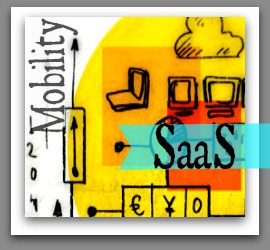Project management is more than just a beneficial skill; it’s a core competency that benefits…

Trends in Project Management Technology
This week I had an unexpected discussion with a retired and hilarious Project Manager with great stories to tell about “old school” project management tools. It was great standing on the sidewalk in 68 degree weather, comparing war stories about how far technology has evolved from the days of spreadsheets.
As a kick-off to our new “Technology Thursday” series we wanted to share some interesting trends occurring in our field.
It’s an exciting time for technology in the field of project management! Providing frequent project status reports and real time project data is the norm; technology gives us the tools to do this. Also, the ability to extract data quickly from multiple systems, analyze it and communicate it as useful and meaningful information is imperative.
As we explore the technology landscape, there are 4 trends in project management technology that are gaining traction:
1. Activity Streams
Wikipedia defines activity streams as a list of recent activities performed by an individual, typically on a single website. For example, Facebook’s News Feed is an activity stream. In business processes, and specifically project management, the technology of activity streams is used as a tool for collaboration and enhanced communication. It allows the project teams to track and communicate task status. Think “social project management.”
2. Mobile
Project management mobile apps for both startups and established companies will continue to gain market share during 2014 and beyond. Mobile apps allow project managers the flexibility of managing things like communication, scheduling, mobile approvals, and task management while on the go. Bitrix24, iScope, Xplan, Pivotal Tracker, and Do are a few mobile apps to help Project Managers better manage their projects. More sophisticated solutions include Mavelink, Clarizen, At Task and Zoho Projects. Some mobile apps are geared towards specific mobile devices like Android or Apple, and most of these apps support our ever-evolving world of social collaboration.
3. SaaS
 Also referred to as the Cloud, the SaaS (Software as a Service) model means that the software is hosted on a web based server instead of being installed on the client’s network. Clients access this software through a web browser. Typically the vendor charges a monthly fee and in return the vendor ensures the software is online and working properly. Hosted solution providers also take care of software upgrades, eliminating the need for the client to manage them.
Also referred to as the Cloud, the SaaS (Software as a Service) model means that the software is hosted on a web based server instead of being installed on the client’s network. Clients access this software through a web browser. Typically the vendor charges a monthly fee and in return the vendor ensures the software is online and working properly. Hosted solution providers also take care of software upgrades, eliminating the need for the client to manage them.
In business, including project management, the trend is migration to SaaS solutions. Imagine the ability to engage in remote real-time collaboration with your project team. In addition to being able to work from anywhere, some SaaS-based project management solutions provide a great platform for document management allowing your project team access to documents from anywhere. Some solutions, like Project Insight can integrate with Microsoft Outlook. Who doesn’t appreciate email alerts for upcoming or overdue tasks?
If you’re considering a SaaS-based project management application, don’t forget to look for an app that:
► can be accessed on mobile devices
► has document storage
► provides flexibility to view data in different ways (e.g. Gantt chart, dashboard)
► provides options for real-time integration with tools useful to your project team (e.g. calendaring for email alerts, activity streams)
► falls within application security protocols and allows you to easily customize security settings.
4. Big Data Platforms
More and more, businesses are faced with the ongoing challenge of capturing, managing, analyzing, and gaining value from their data and information. Big data platforms attempt to manage large data sets and present them to the user in a way that’s meaningful and quick. In project management, we rely heavily on KPIs (Key Performance Indicators), dashboards, metrics and more metrics. Getting access to data is one thing; making sense of the data is just as important.
The amount of data available is growing faster than the ability of the traditional database management tools to manage it. The impact on the field of project management is vast, particularly in the area of data analytics or predictive analytics. Developing expertise in deploying, managing and extracting analytics from big data platforms will become a key competency in the project management profession over the next several years.
Value of Technology
In project management the primary value of technology is how it’s utilized. When the right tools are used, technology is a solution that can help in risk assessment, facilitate scheduling and enhance communication. Starting with a sound process is the precursor to selection of any tool/technology. I strongly believe that technology should support a well-defined process, not the other way around.
Side Note: A few of our current favorite project management tools are SharePoint and MS Project for document sharing, project planning, and collaboration. It will be interesting to see how these tools advance as the above technology trends evolve. What are other project management technology trends that you’re anticipating in 2014?
Chrystal Richardson is Managing Partner of CE Wilson Consulting, a project management and business efficiency consulting firm that has managed projects for technology, mining, medical and manufacturing clients since 2001.
This Post Has 3 Comments
Comments are closed.






[…] Other posts in the Technology Thursday Series: ►Trends In Project Management Technology […]
[…] Thursday Part 3 In part 1 of our Technology Thursday series, I shared upcoming Trends in Project Management Technology. As project management technology quickly evolves, I often turn to MS Project as one of my favorite […]
[…] ►Trends In Project Management Technology ►Techno Speak – 6 Technology Terms Related To The Internet and Web ►MS Project Tips and Tricks […]